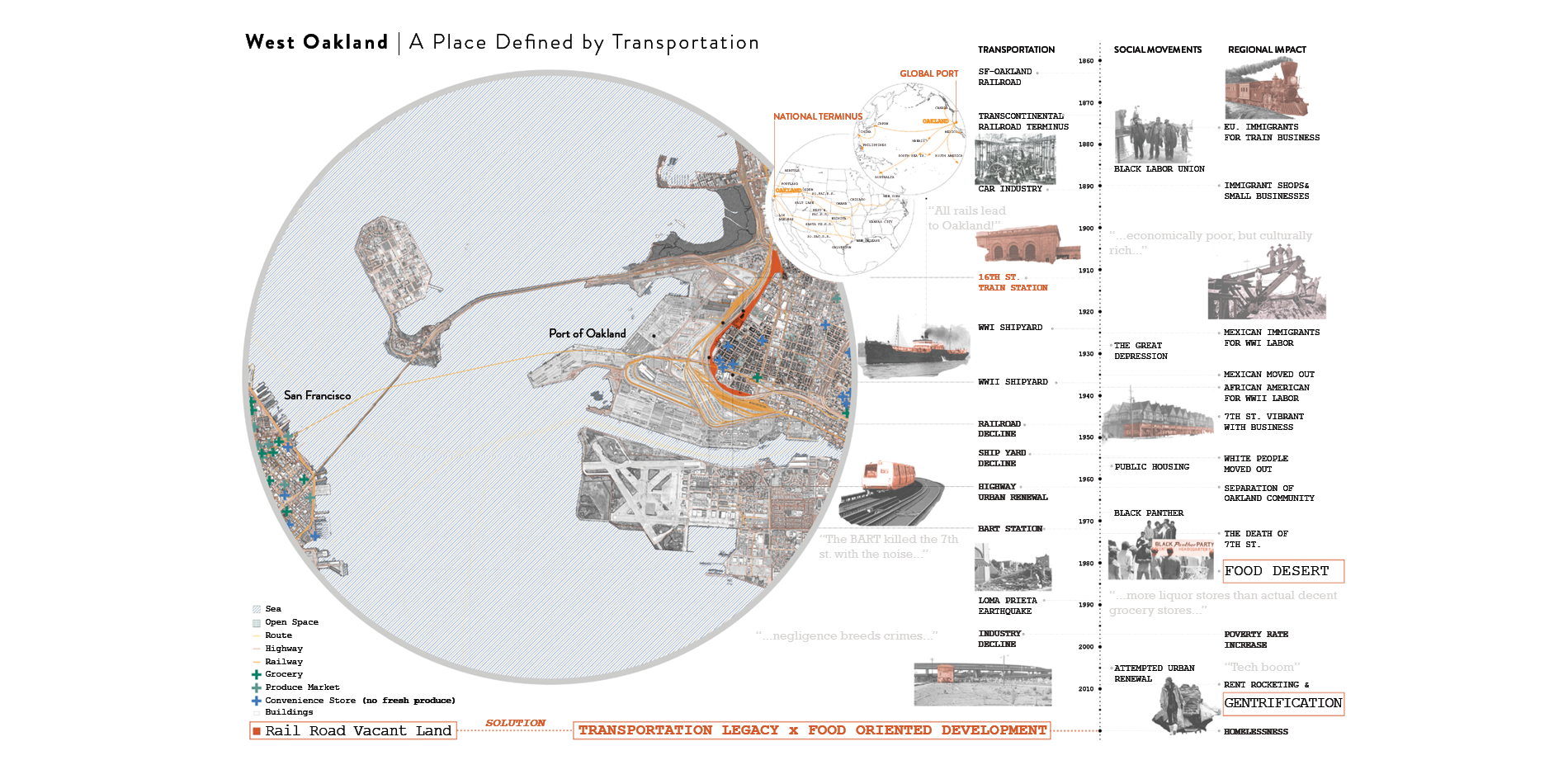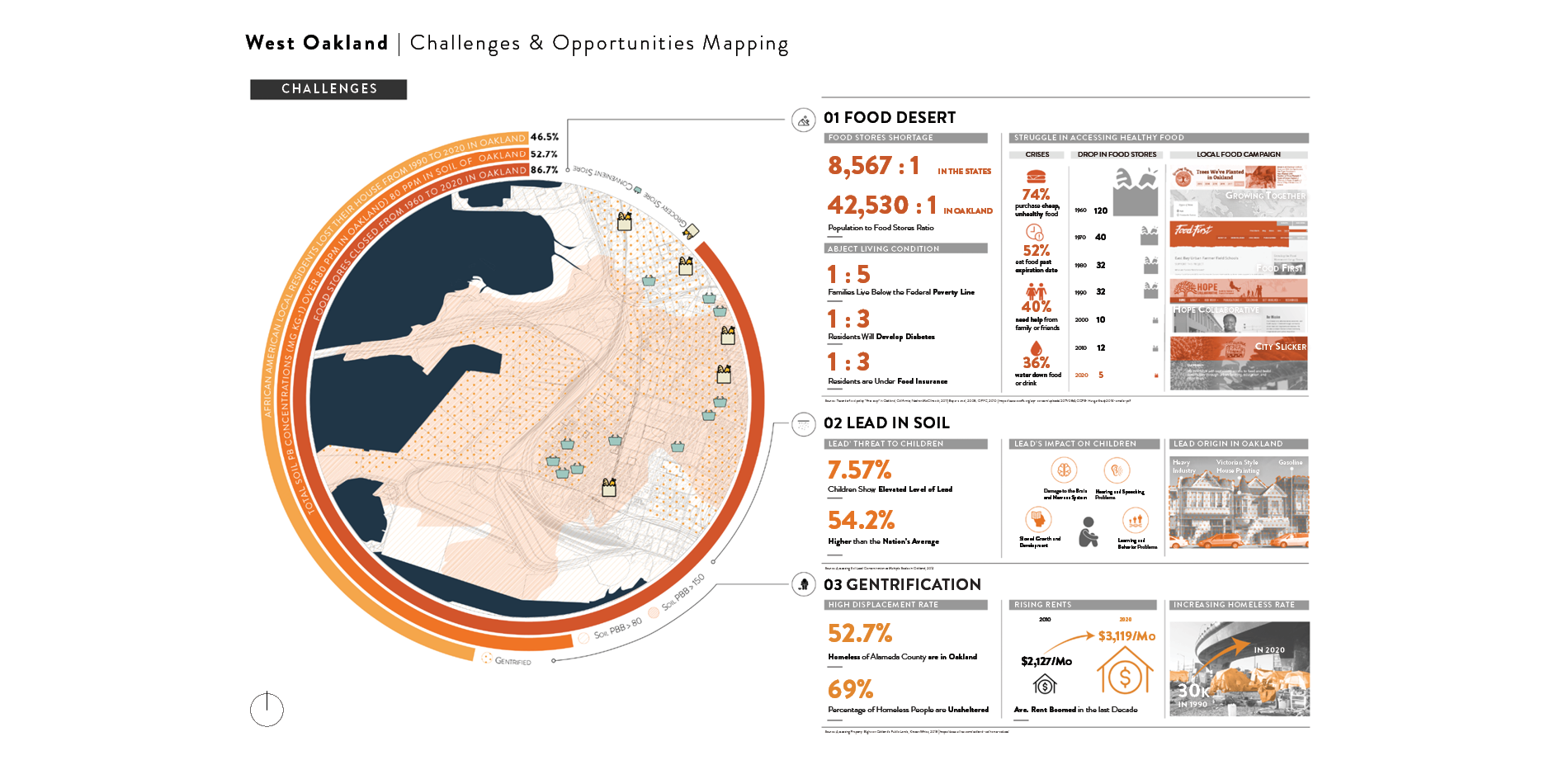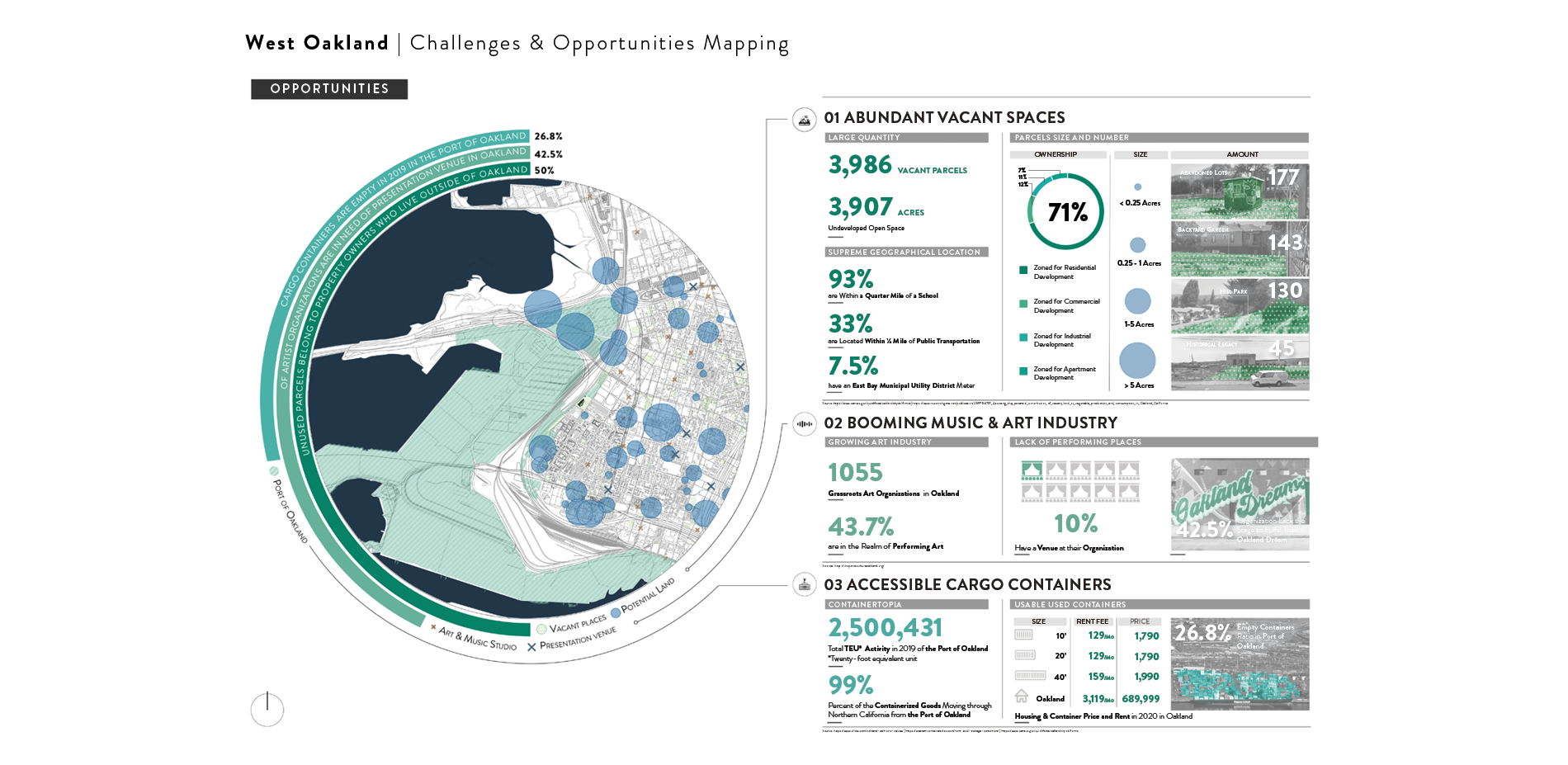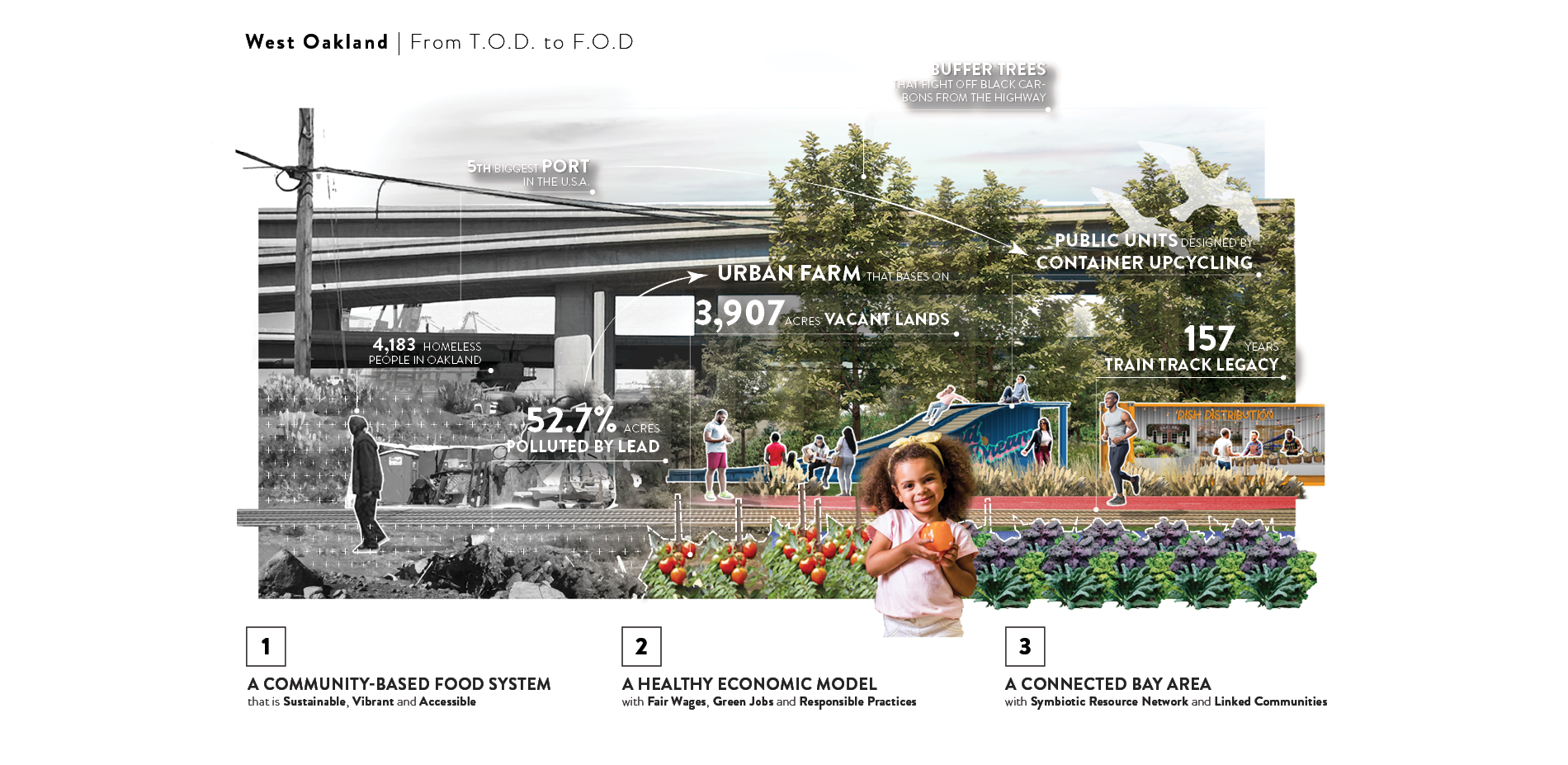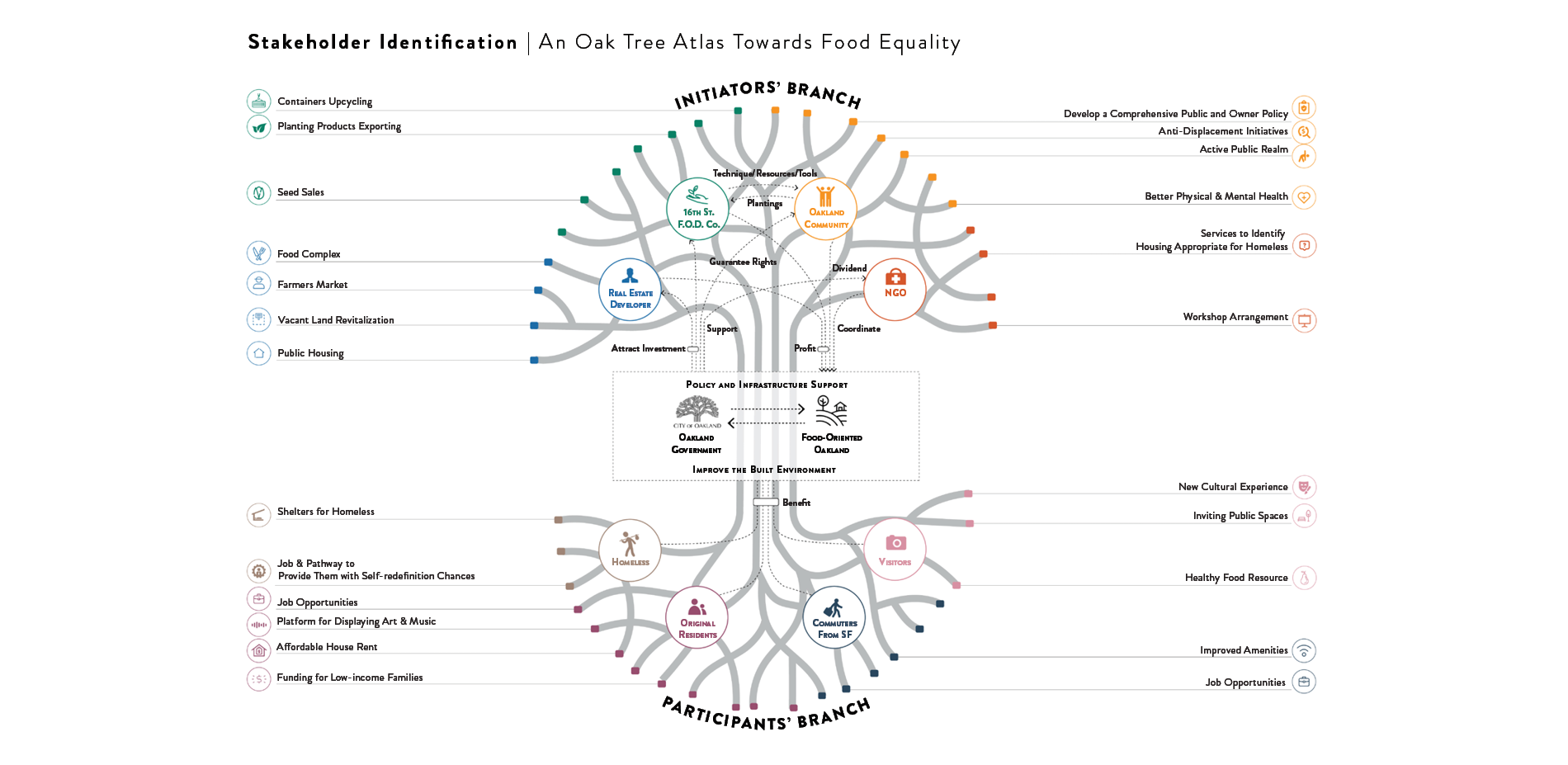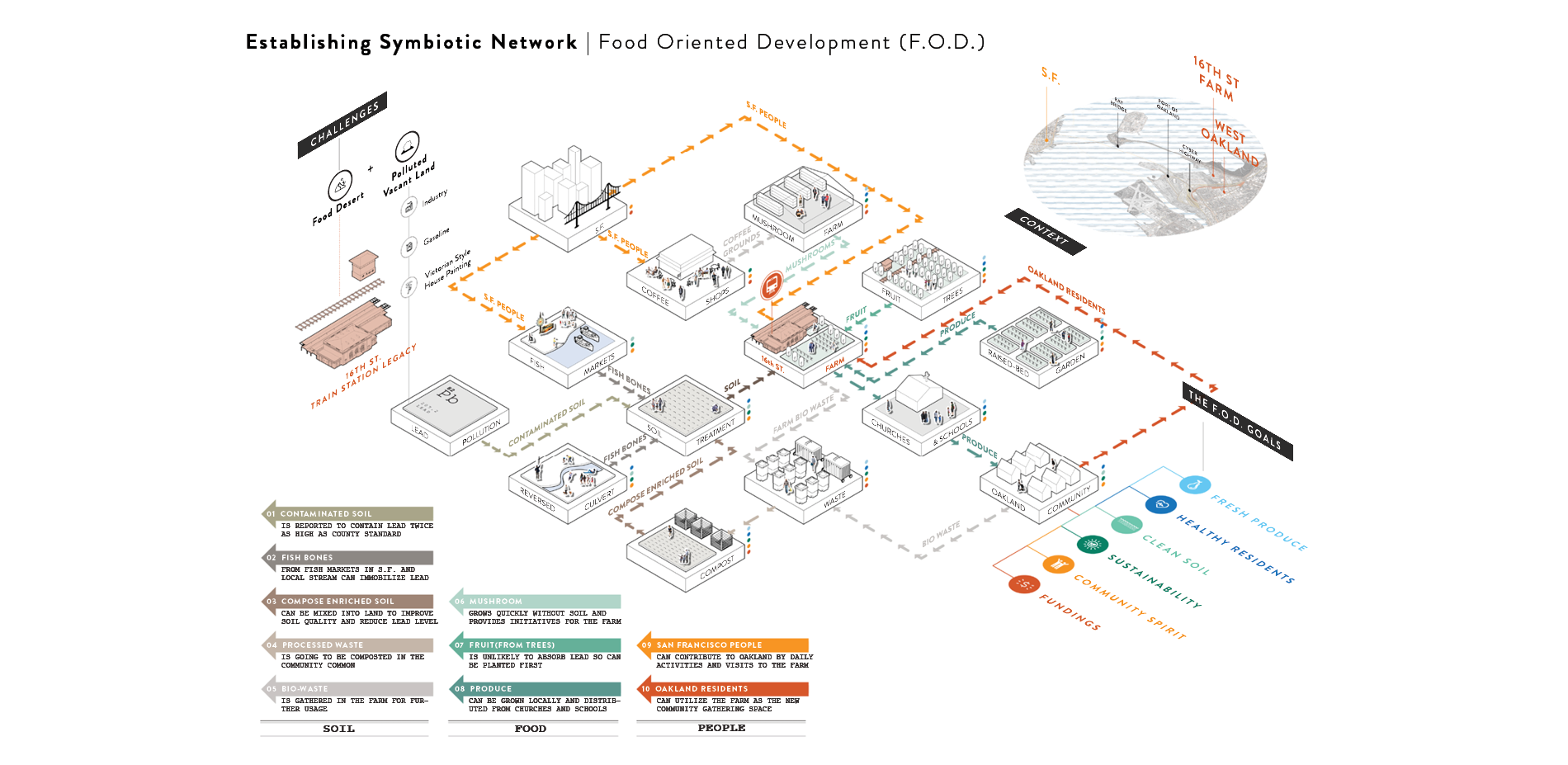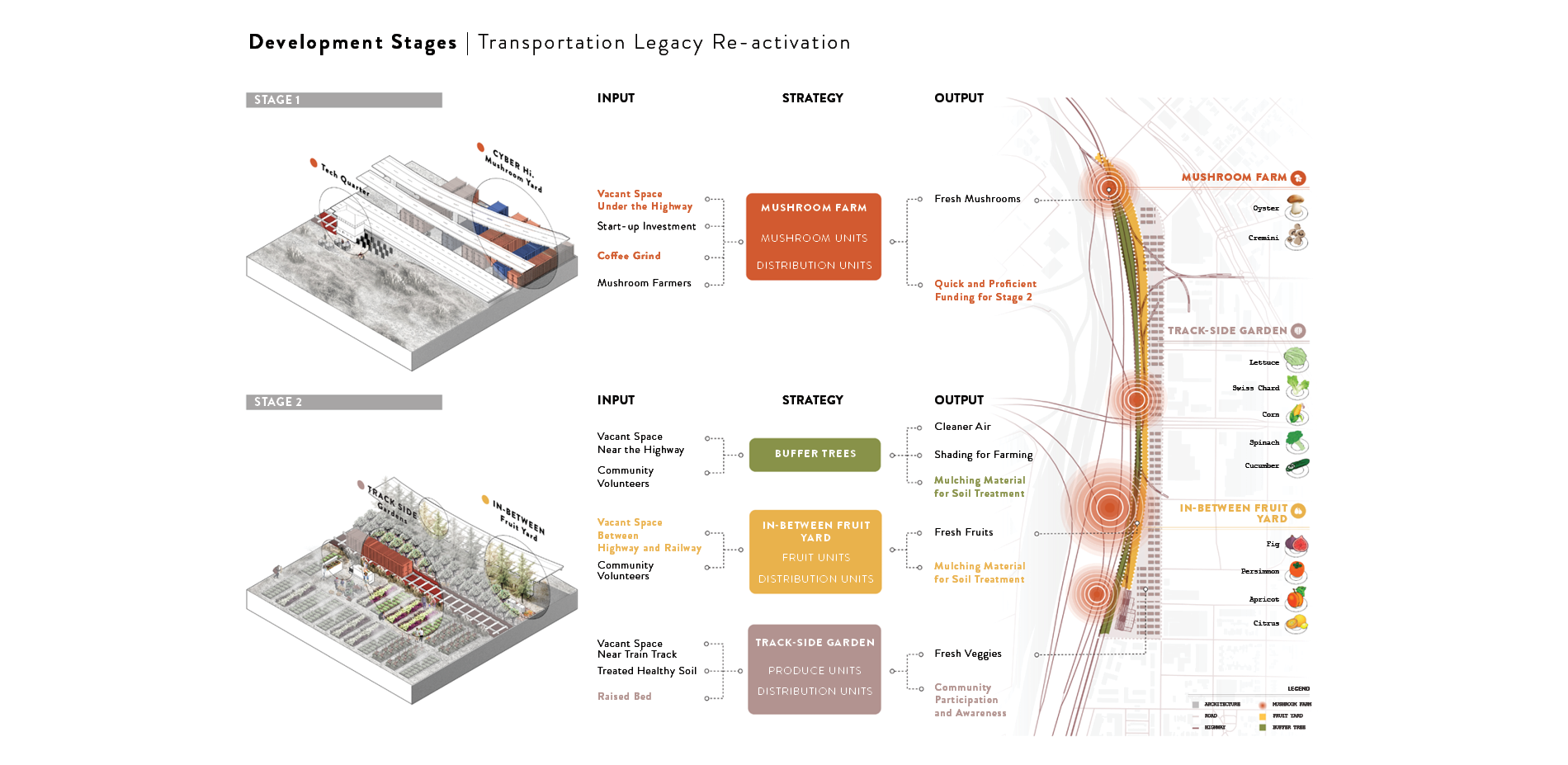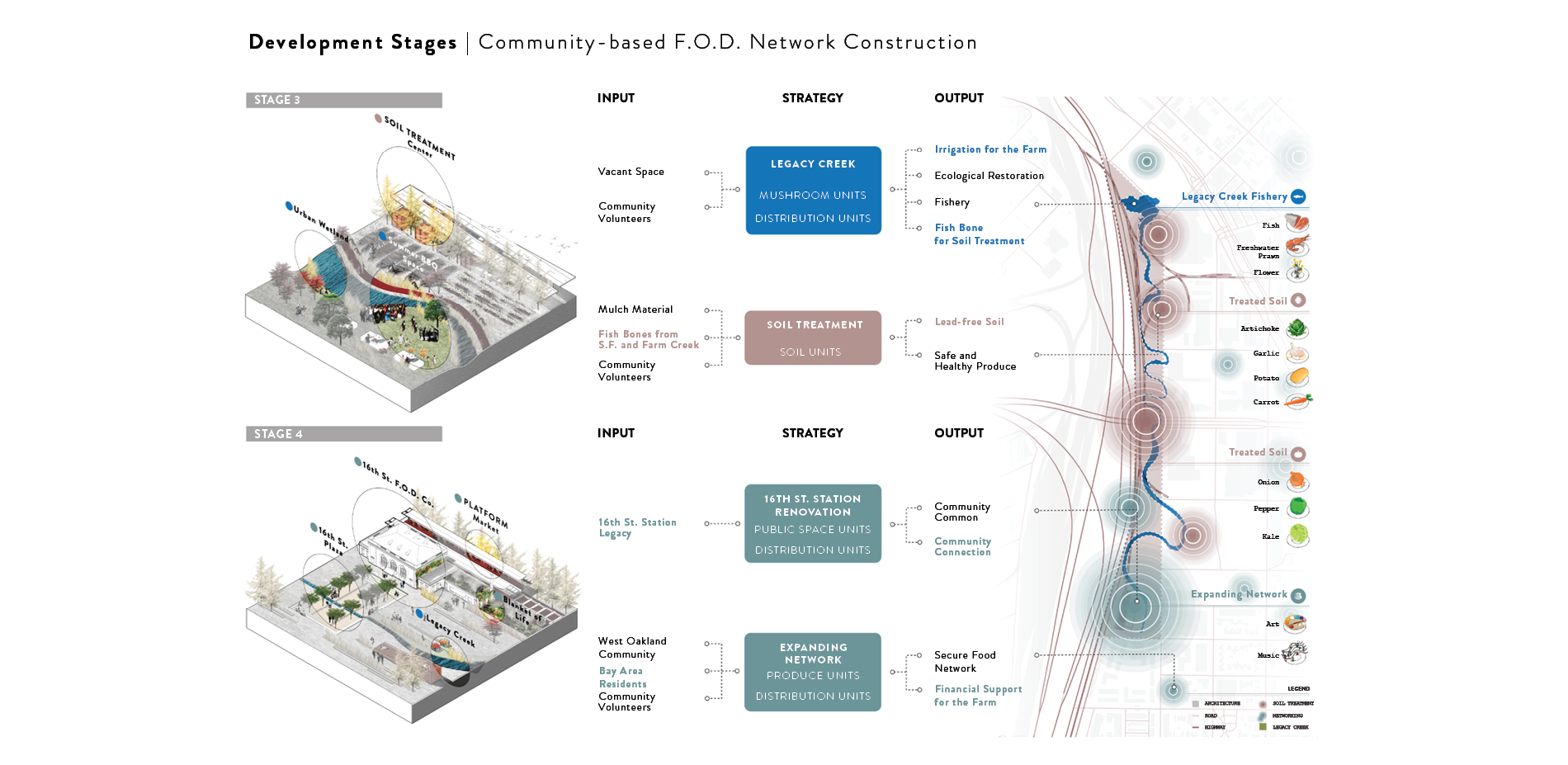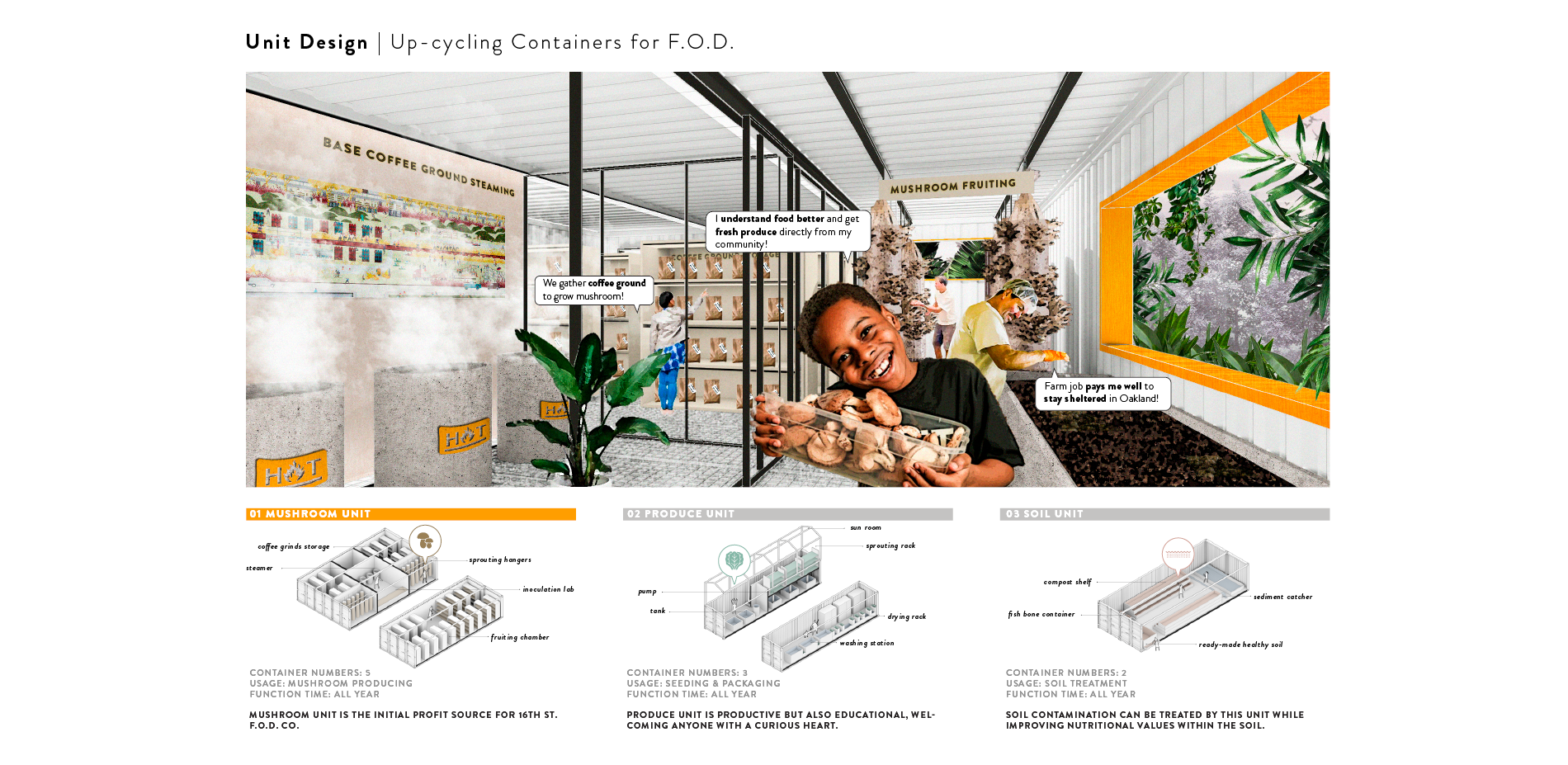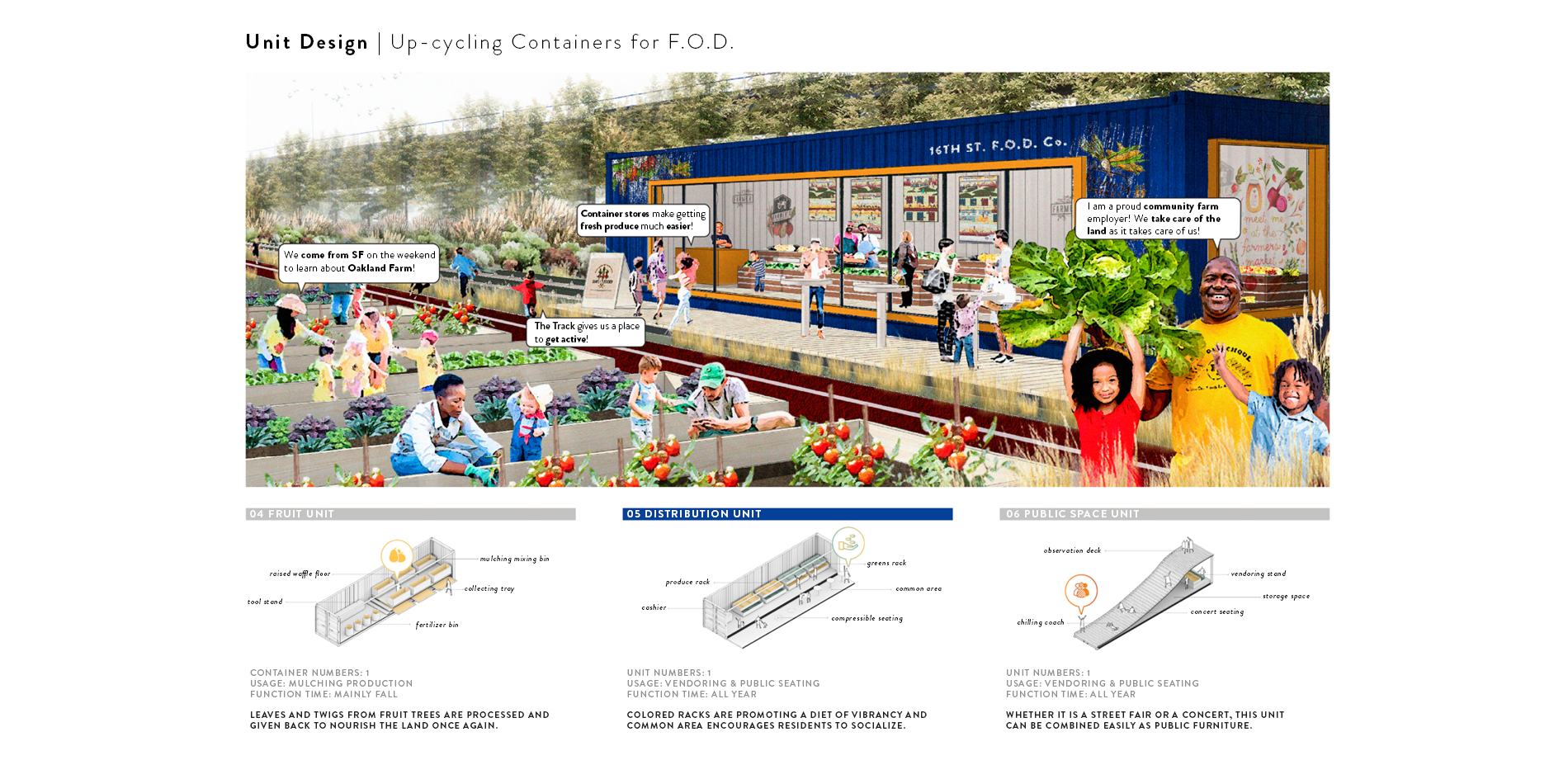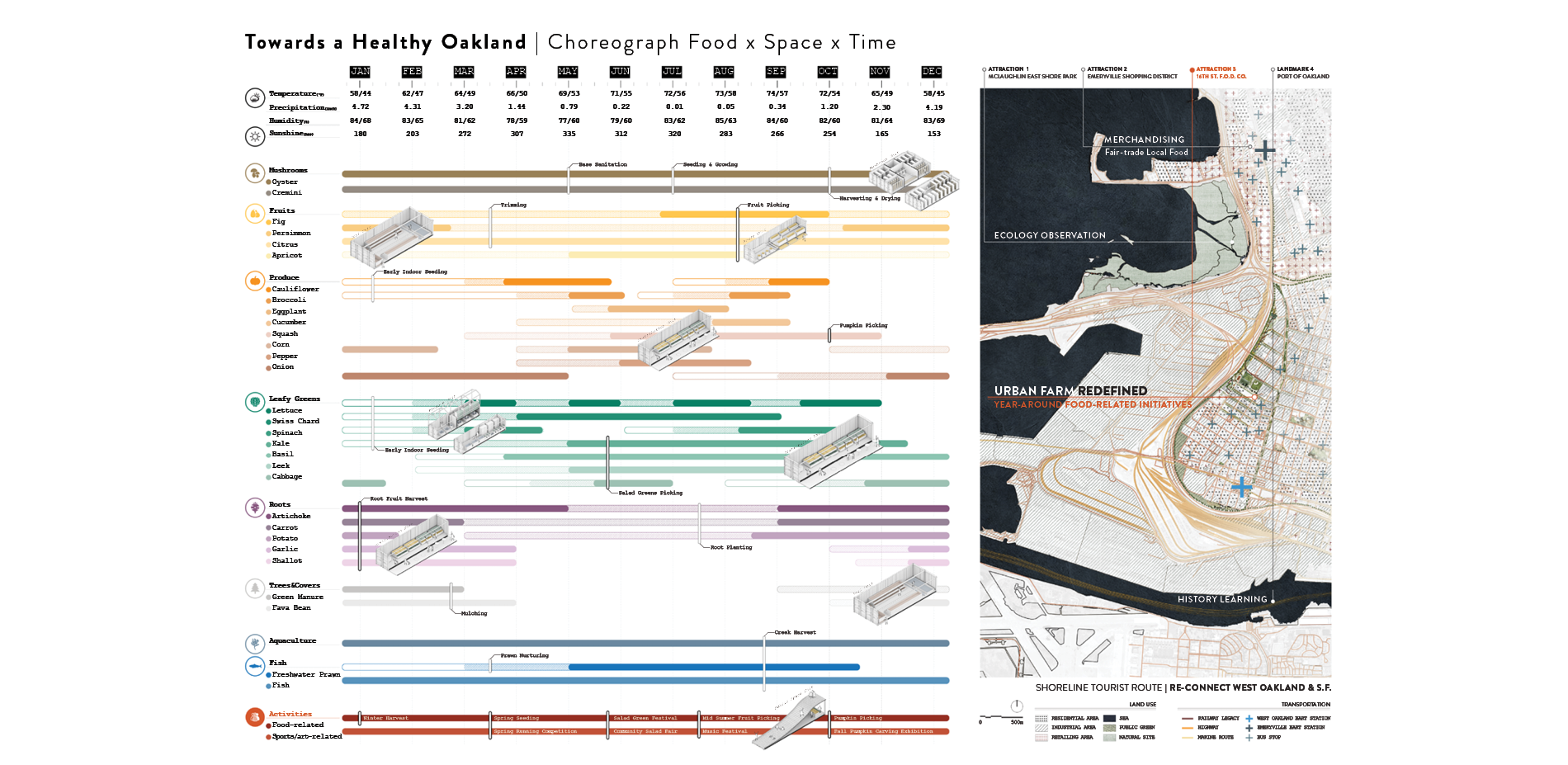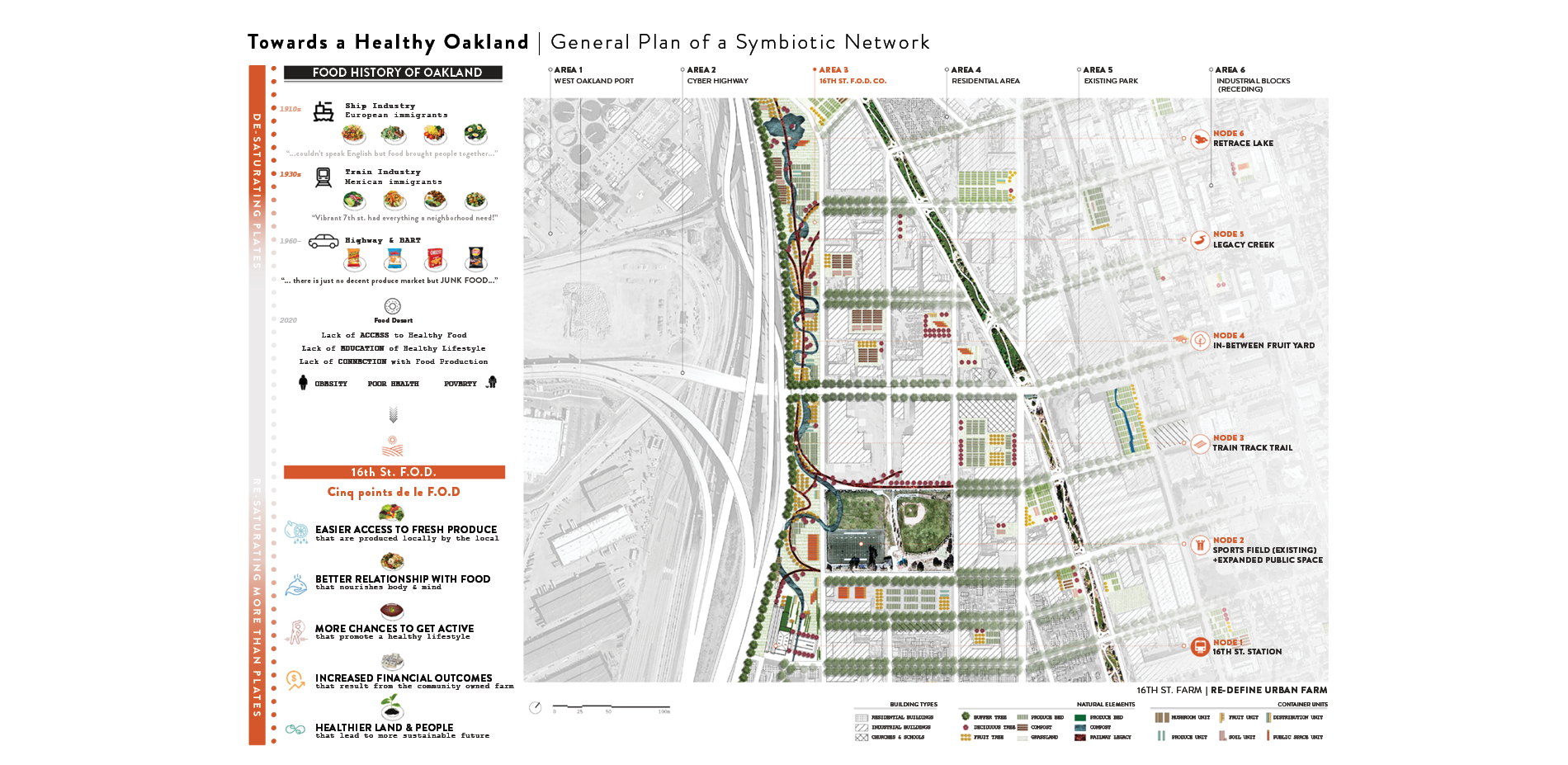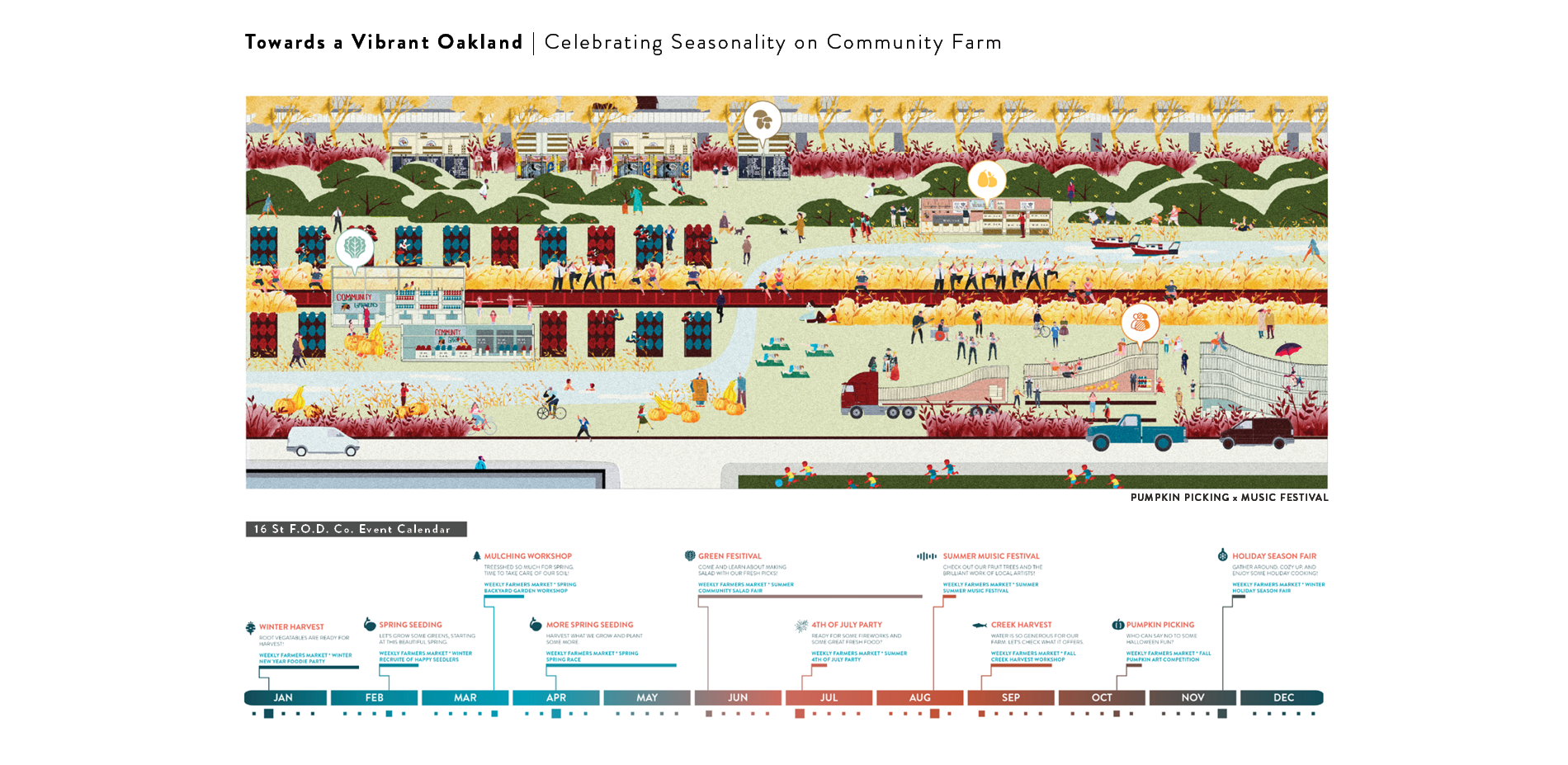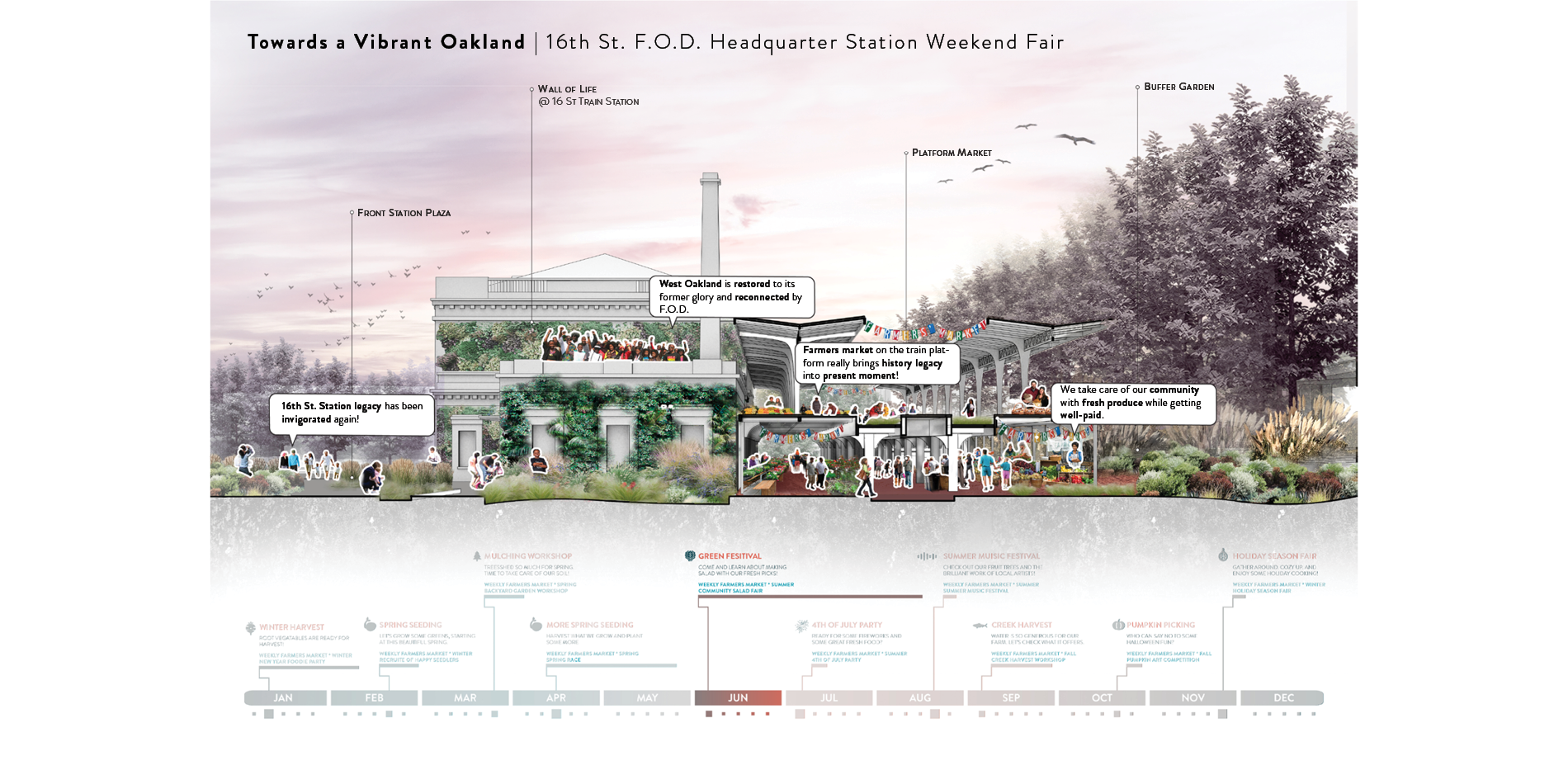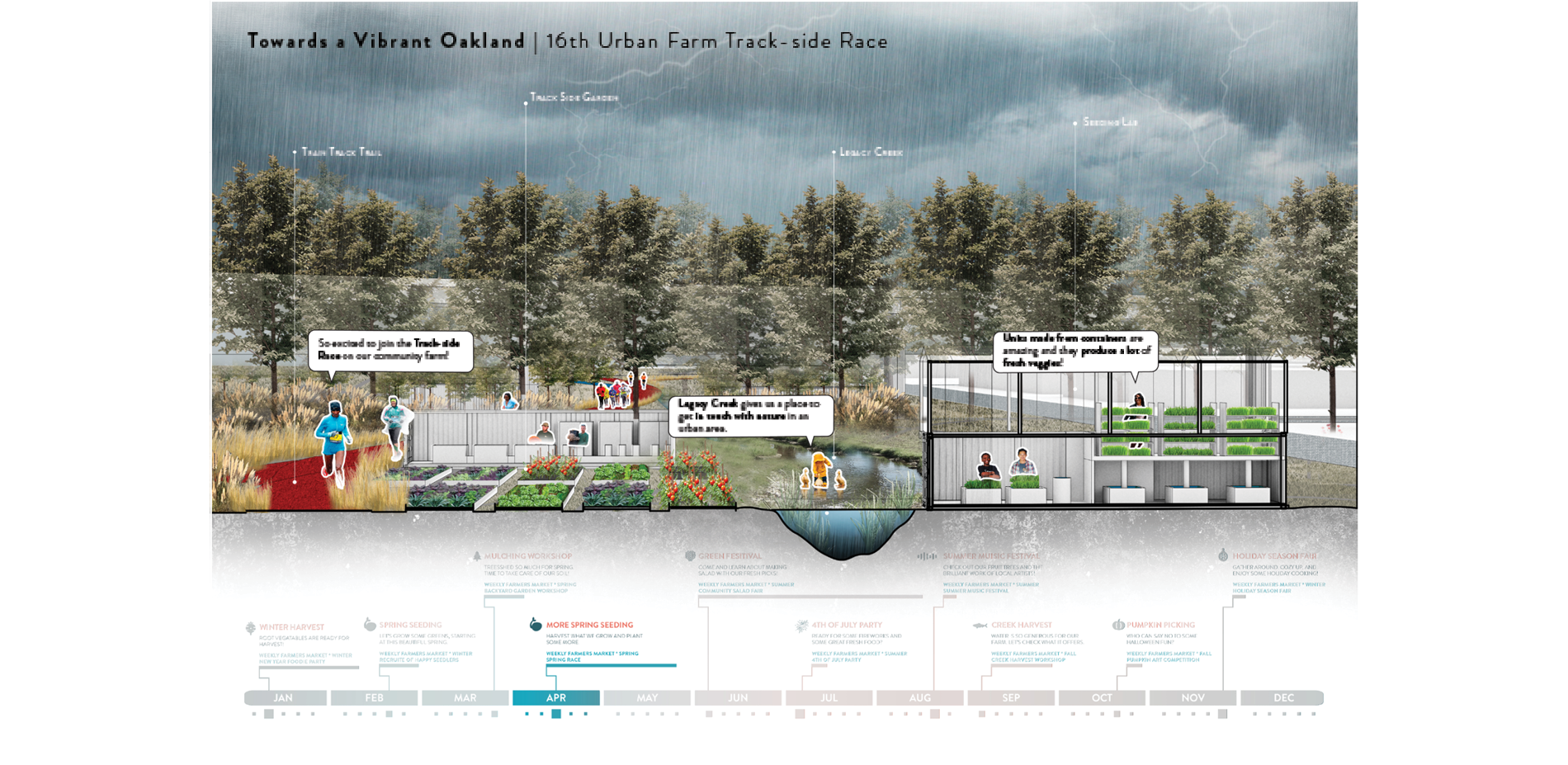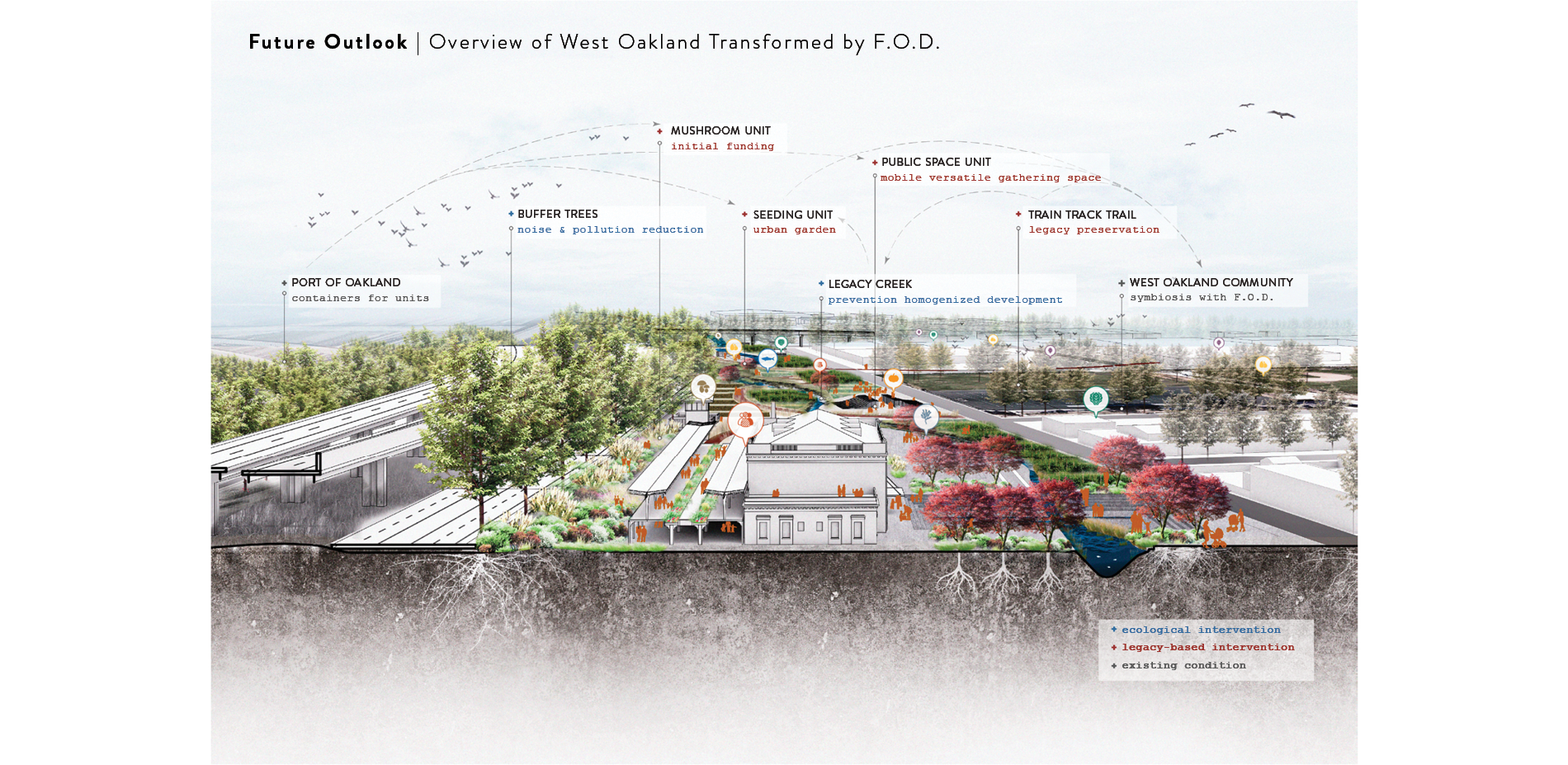West Oakland: From T.O.D to F.O.D | Food Oriented Development on Transportation Legacy
Award of Excellence
Analysis and Planning
Huiwen Shi, Student International ASLA; Lide Li, Student Affiliate ASLA
Faculty Advisors: Tommy Haddock
University of California, Berkeley
West Oakland has a storied history as the western terminus of the transcontinental railroad, but following a 1989 earthquake that left its 16th Street Station damaged and decommissioned, this transit-oriented neighborhood found itself cut off from transit. The historic structure of the station remains, and is the focus of a proposal to address a chronic lack of nutritious food within a gentrifying community. Starting with the station, and branching outward to convert leftover vacant lots into productive, small-scale farms, the plan reimagines the station as a food network hub and a catalyst for healthier growth. Food byproducts aid in remediating industry-contaminated soils while nurturing produce that can begin to replenish the neighborhood nutritionally and financially.
- 2020 Awards Jury
Project Credits
Adviser
Ran Yang
Adviser
Marco Cenzatti
Project Statement
West Oakland has a rich history of industry, social activism, immigration, blending of cultures, and urban developments. Unfortunately, the once buzzing industrial-based district has fallen into deprivation because of the 1960s’ Transit-Oriented Development, which became a force of segregation, leading to a food desert, an unhealthy environment, and failures to provide residents with equal opportunities. Meanwhile, gentrification became a growing threat, due to the economic development of the surrounding Bay Area, which is closing in on the local West Oakland communities.
A new FOOD-ORIENTED-DEVELOPMENT strategy is proposed - to turn around the dire situation environmentally, economically, and most importantly, socially. By tackling the two major hindrances to improving growth and food conditions (in soil contamination and lack of initiatives), the new system starts at the vacant historical train station, transforming a former site of Oakland’s glory into a catalytic site for growth. The Food Oriented Development (F.O.D.) also brings West Oakland to the center of the Bay Area as a new development model, where people are reconnected by the most fundamental elements of life: food.
Project Narrative
A) Site Context
-Rich history: T.O.D & social activism
West Oakland has once been a place of diversity under the impact of T.O.D. With the rise of the transportation industry during the two world wars, the area welcomed thousands of immigrants, from European ship-makers to African American train-builders from the south. The famous 16th train station and its tracks were the beginning of this glorious chapter in West Oakland. It was never hard to grasp the prosperity of the area by their continuously saturating urban life, among which food always played a vital part.
West Oakland has also been subject to inequity through its ups and downs from its past to the present days, especially for the African American community. The T.O.D hit the area hard by rampaging highways and BART lines through the most prosperous region, segregating the community and damaging local business to the point the area’s once colorful urbanity has been completely desaturated, the most obvious sign being the reduced access to fresh and healthy food. With the decline of transportation-related manufacturing, the once prosperous area teems with poverty, transportation legacy abandoned, residents struggling.
However, the district has always exemplified resilience. From the Black Panther Movement to the current food-related campaigns such as HOPE Collaborative, Food First, and Growing together, West Oakland has a long history of social activism that strives to improve the community.
-Current challenges:
By visiting the site and interviewing the residents, we discovered three major imminent threats to West Oakland’s development, which are food desert, vacant yet polluted land, and gentrification.
With grocery store’s accessibility falling ⅕ of the nation’s standard, West Oakland residents face nutritional struggles, especially for the children who are born into this situation in which obesity is rampant. Ironically, children are obese while being malnourished in that they can easily walk into convenience stores and get packaged junk food, while it is challenging for them to find fresh produce within the neighborhood. When they grow up, they will be looking at reduced health, shorter life expectancy, and overall less chance to thrive.
Since the decline of industry, vacant spaces are more available. Why not use that to promote urban agriculture then? The sad truth is that the land is mostly heavily polluted with lead for three reasons: 1)the substantial industrial background, 2) the lead-based Victorian-style painting for houses, and 3) the pollution brought by the highways and logistics. It is shocking to realize that the children in West Oakland show 54.2% higher lead concentration in blood compared to the national level, which means they have a higher risk of growth problems ever since their early stages of life.
Gentrification has taken over since the bay area’s tech boom. With its proximity to San Francisco, the residents of West Oakland have been slowly driven out with the rise of rents and lack of access to higher-paying jobs.
-Extant opportunities:
It is crucial to identify the most prominent problems and turn the challenges into opportunities.
First, with all the vacant land which is unfortunately polluted, it is still possible to find a remedy for the soil. Just across the bay bridge lies the fisherman’s market of San Francisco, which produces incredible fish cuisines and also, fish bones, which are incredibly useful to immobilize lead in soil and are easily accessible.
Second, to gain financial initiatives, the Port of Oakland has offered a large number of cargo containers that can be utilized for urban agriculture units. Meanwhile, the famous 16th Street Train Station, along with parts of the preserved-train-track-covered area, are municipal-owned and could potentially be transformed from the transportation center to a F.O.D. headquarter.
Third, the district has impressive music and art industry that is waiting to be appreciated.
Finally, Oakland has individuals as well as organizations that are striving to improve food accessibility and overall healthy development for the area.
B) Project Statement
To address the problems brought by T.O.D, we proposed a FOOD-ORIENTED DEVELOPMENT (F.O.D) agenda, energizing the district starting with saturating their residents’ plate as an initiative for the overall development. There are three primary goals for the program:
-A community-based food system that is sustainable, vibrant and accessible
-A healthy local economic model that provides fair wages conducts responsible practices
-A healthy community that is connected and active, with residents educated about food and the food system
C) Project Agenda
-Symbiotic network establishment
The project works closely with the community and various stakeholders in cultivating the F.O.D., starting with establishing a symbiotic food network. By creating an oaktree atlas that forges more reliable connections between stakeholders, a better private-public partnership concerning F.O.D. could be established.
A general system is also to encourage the flow of resources: from coffee grounds to mushroom farms, from fish bones to soil treatment, from community wastes to better soil, benefiting the community with clean land, fresh produce, healthy residents, fundings, community spirit, and sustainability.
The operation is divided into several stages. Each provides financial, ecological, or public support for the following, bonding human resources network with the materials and land.
-Sustainable food-related development
Based on the system, the F.O.D. carefully choreographs food, space, and time, beginning on the transformation of the transportation legacy land. Not only does the project provide fresh produce, but it also provides a new community common for raising health and sustainability awareness by encouraging a better relationship with food, providing more space to get active. Furthermore, it gives a chance of rebuilding community spirit and locality.
Considering the site is just near the Port of Oakland with abundant cargo containers, we have designed six units from containers that will serve to produce, take care of the land, bring fresh produce, and act as public furniture to bring people together. The units can be mobilized on the train-track system, providing mobility for a long-term project that deals with the ecological repair while being accessible to the public.
The train tracks and the station are adapted to serve as a F.O.D. transportation system and places to hold public events. The culvert is also restored to a legacy creek intertwined with the track to provide hydrological support, open space and to prevent homogenized development.
-Food as community development initiator
The F.O.D. project is about people and is based on honoring the legacy of the residents: their shared history of transportation, love for music and art, and their passion for life. The farm provides a place for everyone to voice their opinions and bring everyone together by food. The farm belongs to every person in the community. It is about connection. For people, the F.O.D. can provide them with jobs, better health, and so much more. The calendar of the F.O.D. is composed of nature and people who are celebrating seasonality, forming a beautiful connection through the shared interest of life.
Furthermore, the project will reconnect West Oakland with the surrounding area, voicing their identity as a unique and resilient neighborhood.
D) Future Outlook
In the long run, the F.O.D. takes on the train legacy land and expands its practice into other vacant areas of West Oakland. It will promote food security, create green jobs, provide environmental services and education, beautify the neighborhood, encourage civic participation, and empower the citizens. If West Oakland used to be built and destroyed by transportation, food can and will be the new initiative for a better Oakland.
